Upcycled Design Competition 2023
The Wilson School of Design, in partnership with local textile recycling initiative Our Social Fabric, are pleased to present this year's Upcycled Design Competition with the theme of "Protopia". The 10 finalists have created a 3-dimensional design using recycled textiles and found objects that address a meaningful and current topic. Read on to learn more about each of the 9 entries, and cast your vote for your favourite!
The winners of the 2023 competition are:
First place - Nina Rozin, "From Rags to Riches"
Second Place - Emma Juhala, "The Mystical Shawl of Unknown Futures"
Third place - Mehdi Abbasi and Elise Charpentier, "The Girl from Tehran"
People's Choice - Eren Berg, "Ro"
First Place: Nina Rozin - “From Rags to Riches”



Tell us a little about your post-secondary career if WSD is not your first education experience – If so, what made you choose to study at WSD? What year/program are you in right now?
Hi, I am Nina Rozin, a first-year Fashion Marketing student at the Wilson School of Design (KPU). I am also a graduate of the London College of Fashion and a shoe designer by profession. I decided to further my education and specialize in marketing as the next step in my career and use my understanding of the design process as an extra skill when approaching marketing projects.
Why did you want to participate in the Upcycled Design Competition?
As a designer in the fashion world, I am fully aware of the damaging effects of the fashion industry on our planet. The idea of upcycling is an important part of the solution. Being a student again, I have the freedom and time to explore these issues and work to bring more awareness and hopefully encourage more solutions. “Every little helps” is my motto and I want to be part of the change!
The theme of this year's competition is Protopia. What was your perspective on the theme and what do you hope to create through your submission? Can you give us an idea of what you plan on doing for your final submission?
Protopia was a new concept to me, and I found it exhilarating. In a Protopian society, there is a constant sense of progress and growth, and people are optimistic about the future. They are taking account of their actions and working to create change for the better. The concept inspired me to take responsibility and use our “garbage” to create beauty. I want to share this idea of optimism with the viewers and inspire people to take initiative to create change. I can share that the product will be shoes as this is my form of expression. The rest will be shared in the final submission.
Second Place: Emma Juhala - “The Mystical Shawl of Unkown Futures”

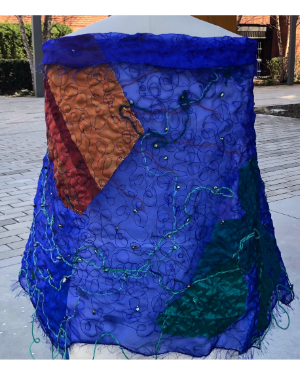

Tell us a little about your post-secondary career if WSD is not your first education experience – If so, what made you choose to study at WSD? What year/program are you in right now?
My name is Emma and I am a 2nd year student in the Fashion & Technology program. I didn’t always know I would go on to study design, but now that I’m here, I couldn’t imagine myself anywhere else.
Why did you want to participate in the Upcycled Design Competition?
I chose to participate in this year’s competition because I wanted to add a piece to my portfolio centred entirely around sustainability. I find that despite sustainability being considered in every project I create, its never the driving force behind my designs. While so much of my portfolio is quite technical, this project will be a more personal and philosophical piece to add to my repertoire.
The theme of this year's competition is Protopia. What was your perspective on the theme and what do you hope to create through your submission? Can you give us an idea of what you plan on doing for your final submission?
To summarize, Protopia it is the concept of making small incremental changes over a long period of time that will hopefully lead to a better more sustainable future. Key word here is “hopefully”. We don’t know if or how the actions we make today will impact our future. My project is based on the vulnerable feeling of blind faith we get from not knowing the effects our actions will have on our futures.
My concept is reflected in the creation of my fabric, which relies on a specific technique of fibre art using water-soluble embroidery stabilizer to gradually attach layers of yarn and fabric scraps. While writing this message I have yet to uncover what my fabric will look like once the stitching is complete, and the stabilizer is dissolved. All the symbolism is in the process of gradually making the fabric without any sense of what it will look like.
Third Place: Mehdi Abbasi and Elise Charpentier - “The Girl From Tehran”


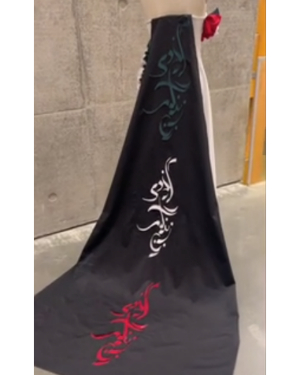
Tell us a little about your post-secondary career if WSD is not your first education experience – If so, what made you choose to study at WSD? What year/program are you in right now?
My name is Elise Charpentier, and I am currently a second-year student in the Fashion & Technology program at the Wilson School of Design. I decided to pursue a career in the fashion industry several years ago, recognizing my interest in design during my last year dancing with the Richmond Youth Dance Company. After taking my first textiles course in Grade 9, I discovered and was drawn to a career in fashion design. Currently, I am striving to further advance my education and aspire in the future to pursue a master's degree in fashion design.
My name is Mehdi Abbasi, and I am a first-year Fashion Design and Technology student. Prior to Joining WSD, I was pursuing general studies at Douglas College. I decided to study general studies at Douglas College due to my family not allowing me to pursue a career in fashion design. After graduating high school I was very certain and determined to study fashion but with the objection of my family, I decided to study what they intended my career to be. After 3 years, I decided to apply to a fashion school without my family knowing, later being accepted into the school but not into the full program. I decided to Study at WSD due to the program being the only option in Vancouver offering what I was looking for. Wilson School of Design and the structure of the programs were designed in a way to help me find a job in the industry at the end of my education.
Why did you want to participate in the Upcycled Design Competition?
Our team is participating in the Upcycled Design Competition to educate and convey how we feel about the current events happening globally, especially with the “Women, Life, Freedom” movement. We continue to feel powerless as we watch the discrimination against Iranian women. Together, we may not be able to create change at a global level, but we do have a voice within our community to bring awareness.
The theme of this year's competition is Protopia. What was your perspective on the theme and what do you hope to create through your submission? Can you give us an idea of what you plan on doing for your final submission?
Our perspective on the theme of a Protopia recognizes individuality, values, community, and religion/spirituality. Our team aspires to take initiative to create incremental change by educating and bringing awareness of the current events and developments in Iran afflicting women; to become a voice to inform the truth and reality of these women. We seek to freely express our emotions and concerns that have grown over months of observing the stories of young women sacrificing themselves for the same freedom we currently indulge. Our team is determined for the design to become a catalyst needed to inspire many around us in the response to how these women have continued to speak up against injustice. This is our opportunity to contribute and become a voice for the “Women, Life, Freedom”. The name of our design is “The Girl From Tehran”.
People's Choice Award: Eren Berg - “Ro”



Tell us a little about your post-secondary career if WSD is not your first education experience – If so, what made you choose to study at WSD? What year/program are you in right now?
My name is Eren Berg and I am a first year student enrolled in Fashion Design and Technology at WSD. Deep down, I have always had a passion for fashion design, and now I am able to translate that passion into reality by studying at WSD! Originally from Edmonton Alberta, I had the opportunity to tour the WSD campus during my last year of high school, and I knew at once that it was my dream school! I could tell almost immediately that it would provide the enabling environment and education that I would need to pursue my career! I am proud to call myself a KPU Wilson School of Design student - I really can’t wait to see what the next four years will bring!
Why did you want to participate in the Upcycled Design Competition?
When I first read the announcement for the Upcycle Design Competition, I eagerly jumped at the opportunity! I am no stranger to upcycling fabrics, as I have always tried to stay keenly aware of my environmental impact. Ever since I was a kid, I have researched ways to reduce my carbon footprint, whether by limiting my material consumption, buying second-hand, using public transport, or becoming vegetarian. A turning point was in 2022 when I had the privilege of exploring the world for three months during a Grade 12 study abroad program. I experienced the unique cultures and geography of Australia, Indonesia, Singapore, Cambodia, Vietnam, and South Korea. Though many of these countries are extremely biodiverse and naturally beautiful, the effects of climate change are also becoming very apparent. I got to snorkel the Great Barrier Reef of Australia, where I noted that most of the coral was gray and looked husk-like, due to the recent coral bleaching events. In Cambodia and Vietnam, single use plastic was littered everywhere due to the fact that you could not drink the water unless it came from a plastic bottle due to the pollution. Though trees and jungles covered the land of Bali Indonesia, the air was always smoky. The locals refer to it as “smog” (smoke and fog). Bali is one of the world’s largest sources and producers of palm oil, which is known for having unethical cultivation techniques, such as burning down whole forests. Experiencing the smoky air, dying coral reef, and abundance of plastic first hand amongst such environmentally picturesque countries was jarring, but also motivating. Living in Canada, where we have the resources and ability to start making a difference regarding climate change, I now seek to make as meaningful and positive an impact on our environment as possible! With that said, I believe that upcycling and thrifting for second-hand garments and fabrics is one major step in reducing global waste and I knew I had to enter the Upcycle Design Contest!
The theme of this year's competition is Protopia. What was your perspective on the theme and what do you hope to create through your submission? Can you give us an idea of what you plan on doing for your final submission?
As noted, my theme is about sustainability and reducing fabric waste. With this considered, I wanted to make the most out of the fabric and materials I was provided with! My design, Ro, is a pair of wide-legged, neutral toned pants and a navy blue triangle bag. However, these two garments are not just solo pieces. The triangle bag, as well as the inseam of the pants can unsnap. The wearer can then attach one side of the triangle bag to the front of the pant, and one to the back. We have now created a skirt out of pants and a bag! Again, in regards to this year’s theme, Protopia, I sought to combine the theme with my passion for sustainability. Protopia as a concept stated by Kevin Kelly, is “Crawling toward betterment - how we build the future, 1% at a time.” Personally, I see no better future than one that majorly reduces material waste! Forget your bag at home when grocery shopping? Unsnap the skirt, snap up the pants and the triangular parts and boom! No need for a plastic bag! In the end, Ro takes sustainability to a whole new level by being three unique pieces out of one large garment!
Victoria Chew - “Fabrication”



Tell us a little about your post-secondary career if WSD is not your first education experience – If so, what made you choose to study at WSD? What year/program are you in right now?
I chose to study at the WSD because I enjoyed my high school textiles program. It was really one of the only few things I enjoyed and was decent at, so I worked toward getting into the WSD since grade 9. Right now, I am a second year in the Fashion Design and Technology program.
Why did you want to participate in the Upcycled Design Competition?
I feel like it is one of the few projects where you can really express your creativity and workmanship outside of the industry’s expectations of conventional clothing. I want to make something that isn’t just for a target market.
The theme of this year's competition is Protopia. What was your perspective on the theme and what do you hope to create through your submission? Can you give us an idea of what you plan on doing for your final submission?
Protopia is a term that refers to the concept of “something that is better today than it was yesterday.” In line with the protopia theme, I wanted to make a haori jacket concept that is designed with the future in mind. It will utilize denim. A tough fabric that takes a long time to decompose that utilizes lots of resources to manufacture. The denim will be used as a foundation to build the jacket, utilizing denim scraps, off-cuts, and old denim garments as its primary fabric source. They will be sewn together to make a large piece of fabric, preferably a metre and a half in length and a meter in width. The jacket will then be cut out from this fabric and sewn accordingly. Decorations will then be cut out and sewn into the back of the jacket, each with different perspectives on the ‘protopia’ theme.
Rachel Denison - “Fungi Forager”



Tell us a little about your post-secondary career if WSD is not your first education experience – If so, what made you choose to study at WSD? What year/program are you in right now?
After graduating high school in 2017, I attended a 6-month study abroad program in Germany. Since then, I have also done a year of general studies and a year of majoring in Geography at Vancouver Island University. I really enjoyed studying Geography, but decided to take a break during COVID. During that time off, I found myself looking for a more hands-on approach to learning and wanting to be more creative. That is when I learned how to crochet, which was a turning point for me in discovering hand-made clothing/slow fashion. I have always had an interest in fashion, and through learning about environmental sustainability when studying geography, I wanted to find a way to put these two interests I have together and be a part of the change towards a more sustainable fashion industry. I’m currently in my first year of the Fashion & Technology program!
Why did you want to participate in the Upcycled Design Competition?
As soon as I read the details about the competition, I was eager to get started. I have always loved thrifting and finding creative ways to re-use things I already have. The competition resonated with me, as I am passionate about having a sustainable approach to creating, and being mindful of environmental impacts.
The theme of this year's competition is Protopia. What was your perspective on the theme and what do you hope to create through your submission? Can you give us an idea of what you plan on doing for your final submission?
Protopia is about creating a better, more sustainable future. I decided to use this theme to open up a discussion about regenerative practices in fashion and agriculture, and how they are interconnected and need to work together in order to build a better future. Regenerative fashion connects fashion to nature and people, by collaborating with local communities, artisans, and farmers. To relate this to my design, my submission will focus on traditional crafting techniques, like weaving, and crochet, I will be using biophilic design concepts to create my garment to represent the connection between nature, people, and fashion. Biophilic design explores how humans have a tendency to seek out connection with nature and living things. It is often to create a balance between nature and man-made, bringing the outdoors indoors. I will be focusing on representing fungi, bacteria, and moss, as they are key parts of a thriving ecosystem. They often thrive on decay, which will be used as a metaphor for the regrowth, regeneration, and adaptability of the fashion industry- turning something bad into something positive, growing back stronger than before. For my final submission, I will be making overalls. I chose overalls because that are a common workwear garment to represent artisans and farmers, who are fundamental to regenerative fashion and agriculture practices. The overalls will have a lived-in, earthy look, as if nature has overtaken them and that the garment is biodegrading. This will be done using crochet, weaving, and embroidery techniques to create moss-like textures with yarn, twine, and felt. Natural dyeing will be used on the base material to create the earthy tones.
Nilvia Rojo Morales and Samantha Spencer - “ENSO”



Nilvia
Tell us a little about your post-secondary career if WSD is not your first education experience – If so, what made you choose to study at WSD? What year/program are you in right now?
I am First year, product design Student. This is my second degree, I first studied marketing but after a few years of working I realized my passion is design, so I decided to further my studies and enrol on the Product design program. I chose WSD because of its hands on program and the many real-life challenges they give the students to develop their skills.
Why did you want to participate in the Upcycled Design Competition?
The topic really inspired me and sparked my creativity to bring awareness about global warming and consumerism in a very positive way.
The theme of this year's competition is Protopia. What was your perspective on the theme and what do you hope to create through your submission? Can you give us an idea of what you plan on doing for your final submission?
We got inspired by the idea of challenging consumerism, and designing a product that would serve multiple purposes and avoid the need of purchasing multiple items. We are developing a backpack to fit our urban style; it is a modular bag. It will include a fanny pack that can also be used as a crossbody and a bike bag to attach to the frame of your bike. Whichever the situation you can take the parts you need from your Enso backpack. Modular items allow for easy repairs and avoid the need to replace the entire item. It also allows for design patterns to be changed.
Samantha
Tell us a little about your post-secondary career if WSD is not your first education experience – If so, what made you choose to study at WSD? What year/program are you in right now?
Hi, I am Sam! I am a first-year product design student at the Wilson School of Design transferring from engineering. I chose to study at the Wilson School of design because of the hands-on experiences and free creativity they give to the students.
Why did you want to participate in the Upcycled Design Competition?
I decided to participate in the Upcycled Design Competition because I wanted to challenge myself by designing things in a different design medium than what I am used to. I also saw it as an opportunity to put the skills I have learned in school into practice.
The theme of this year's competition is Protopia. What was your perspective on the theme and what do you hope to create through your submission? Can you give us an idea of what you plan on doing for your final submission?
Our group's version of a protopia is one with minimal waste, sustainability, and respect for nature. Since we are only first year students in the Product Design program, we are not as strong in the production of soft materials. However, we hope to at least create a conversation about how people use certain products and how they affect the environment and systems around them. The bag we designed is called “ensō” to represent unity and cycles as well as freedom and movement when creating.
Hana Story - “Live Not by Lies”

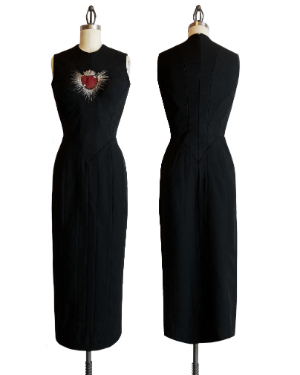

Tell us a little about your post-secondary career if WSD is not your first education experience – If so, what made you choose to study at WSD? What year/program are you in right now?
I am currently in my third year at the WSD. Though I had originally planned to study abroad, I chose to attend locally when travel became impossible in 2020.
Why did you want to participate in the Upcycled Design Competition?
I wanted to participate in the competition as this is the first year in which I feel that my skill level, workload, and interest in the theme have sufficiently aligned to do so.
The theme of this year's competition is Protopia. What was your perspective on the theme and what do you hope to create through your submission? Can you give us an idea of what you plan on doing for your final submission?
Protopia as a concept positions itself in contrast to utopia and dystopia—two states which, though opposite in theory, prove to be more or less comparable in practice. The brutality of utopianism lies in its inability to tolerate dissent, as the mere presence of those who do not concede to the society’s purported perfection pose a direct threat to the utopia’s existence as such. Given the complexity of human nature and the low-resolution, one-dimensional societal vision offered by utopian ideologies, utopias must rely at base upon a profoundly inhuman attempt to reshape the nature of man, both body and soul.
Though most all socialist ideology incorporates utopian idealism, what is perhaps the most notorious and most disastrous example is that of what occurred in the Soviet Union. Aleksandr Solzhenitsyn famously wrote of his time in the system of labour camps he termed “the Gulag Archipelago,” its bleak conditions, and his analysis of what factors contributed to the USSR becoming so unbelievably corrupt. The conclusion was this: personal participation in societal lies. The message of Solzhenitsyn’s writing is fundamentally that it is up to every individual to refuse to participate in the continuation of lies and distortions of the truth, and that every man is responsible in no small part for the conditions of the society in which he finds himself. He spoke of the “spiritual death” that comes upon a population that has been demoralized by being forced to accept and propagate demonstrable lies— a state from which it is difficult to ever recover fully. In his essay Live Not by Lies Solzhenitsyn writes, “Maybe something will happen by itself. But it will never happen as long as we daily acknowledge, extol and strengthen — and do not sever ourselves from — the most perceptible of its aspects: lies. […] Violence does not lay its paw on every shoulder every day: it demands from us only obedience to lies and daily participation in lies. And this submissiveness is the crux of the matter. The simplest and most accessible key to our self-neglected liberation is this: personal non-participation in lies. Though lies may conceal everything, though lies may control everything, we should be obstinate about this one small point: let them be in control but without any help from any of us. […] Either truth or falsehood: towards spiritual independence or towards spiritual servitude. And he who is not sufficiently courageous to defend his soul— don't let him be proud of his 'progressive' views, and don't let him boast that he is an academician or a people's artist, a distinguished figure or a general. Let him say to himself: I am a part of the herd and a coward. It's all the same to me as long as I'm fed and kept warm.”
My conception of protopia is one in which every man agrees never to knowingly promote falsehoods, nor tacitly assent through timid silence to what he does not believe to be (and is self-evidently not) true, even at the risk of great personal harm. As noted by Solzhenitsyn in his Harvard address, “From ancient times, decline in courage has been considered the beginning of the end.” We must realize the way in which even small lies metastasize to envelop the whole societal body— lies content to kill millions in service of the billions, in which the perfect ends always justify the bloody means. We must prevent the slow distortion of objective reality into a matter of ideology or political utility. Through this project, I aim to emphasize the danger of the growing sympathy in the West for utopian thinking, and the way in which every individual has the capacity and responsibility to reject its encroachment. In the writer’s own words: “It's dangerous. But let us refuse to say what we do not think.”
Josh Swanson - “Sway - Fidget Chair”

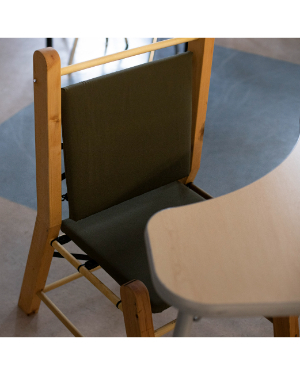
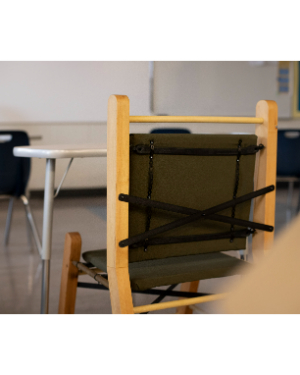
Tell us a little about your post-secondary career if WSD is not your first education experience – If so, what made you choose to study at WSD? What year/program are you in right now?
Growing up in a small town in Southern Alberta I didn't have many of the opportunities available to me that I was interested in. Because of this I tried various programs and courses at my local college before realizing that it simply wasn't worth it to power through something I wasn't passionate about. In 2020, my family and I made the difficult decision to uproot and head to Vancouver. With covid dragging on, we returned to Southern Alberta after a year, and I have been travelling back and forth to complete my studies. I did plenty of research prior to applying for Interior Design school and found that WSD was consistently revered as one of the top 2 or 3 design schools in the country - now in my second semester of my 3rd year, it has been worth it, and I am where I am supposed to be.
Why did you want to participate in the Upcycled Design Competition?
I am incredibly passionate about environmental sustainability and the use of recycled, reclaimed, or repurposed materials. I first competed in the OSF competition last year and placed 3rd, it was a lovely experience and one I intend to continue in my senior year.
The theme of this year's competition is Protopia. What was your perspective on the theme and what do you hope to create through your submission? Can you give us an idea of what you plan on doing for your final submission?
The theme "Protopia" sparked in my mind the idea of developing a design which can seamlessly integrate into an existing system while making a notable impact. I believe that many of our man-made systems could use an overhaul, but I wanted my solution to be completely plausible and entirely achievable by us as designers. This brought me to a topic which is personal to me on multiple levels, educational furniture. My wife is a teacher, and I am an individual who has always struggled with the rigid structure of school and its furnishings - now a father of 3, my eldest daughter also struggles to sit still in the classroom and unfortunately the furniture (desks, tables, chairs) does nothing to support her. I have designed, and plan to create, a chair made of recycled materials which can easily be swapped for existing school chairs allowing multi-directional user-controlled movements to improve focus and reduce sensory integration stress. While serving the students who use them, the chair will also serve as an educational tool for the importance of using reclaimed and recycled materials.
Evelyn Wang - “Heart Of Hands”



Tell us a little about your post-secondary career if WSD is not your first education experience – If so, what made you choose to study at WSD? What year/program are you in right now?
I am currently a second-year fashion marketing student. I’ve always had a passion for sewing and thoroughly enjoyed marketing classes in high school. So during my graduation year, I researched schools and discovered the fashion marketing program. The content of the program made it clear that it would be perfect for me, as I've been seeking to learn the business side of fashion as well as design.
Why did you want to participate in the Upcycled Design Competition?
I heard about the Upcycled Design Competition last year but wasn’t able to do it due to my busy schedule. However, since it’s my last year in the program, I figured that I would push forward and give it a chance anyways. As fashion marketing students we learn how badly fast fashion impacts our environment, so I wanted to bring more awareness to this issue by partaking in this competition. Also, as a fashion consumer, I’m able to produce unique ideas on ways to upcycle clothing from experience.
The theme of this year's competition is Protopia. What was your perspective on the theme and what do you hope to create through your submission? Can you give us an idea of what you plan on doing for your final submission?
Protopia is about making today better than yesterday, but what if today isn't promised? How can we have a clean environment when we are constantly consuming more than we need? In 2023, fast fashion broke its production records, so my design concept is inspired by our planet and fast fashion. Since the rise of global fast fashion clothing companies, people don’t understand the time and effort it takes to make clothing. It requires hours with or without sewing machines and insurmountable amounts of resources to produce. Consumers also often fail to appreciate quality over quantity and forget about being conscious when buying an article of clothing. Being aware of the production of a single piece of clothing is not common, so it’s easy for consumers to buy more without realizing the impact a single article of clothing has on the environment. For my piece, I’ve decided to create a jacket with the back of it showcasing a heart covered by hands, to show how many hours people put in to make a single garment.
